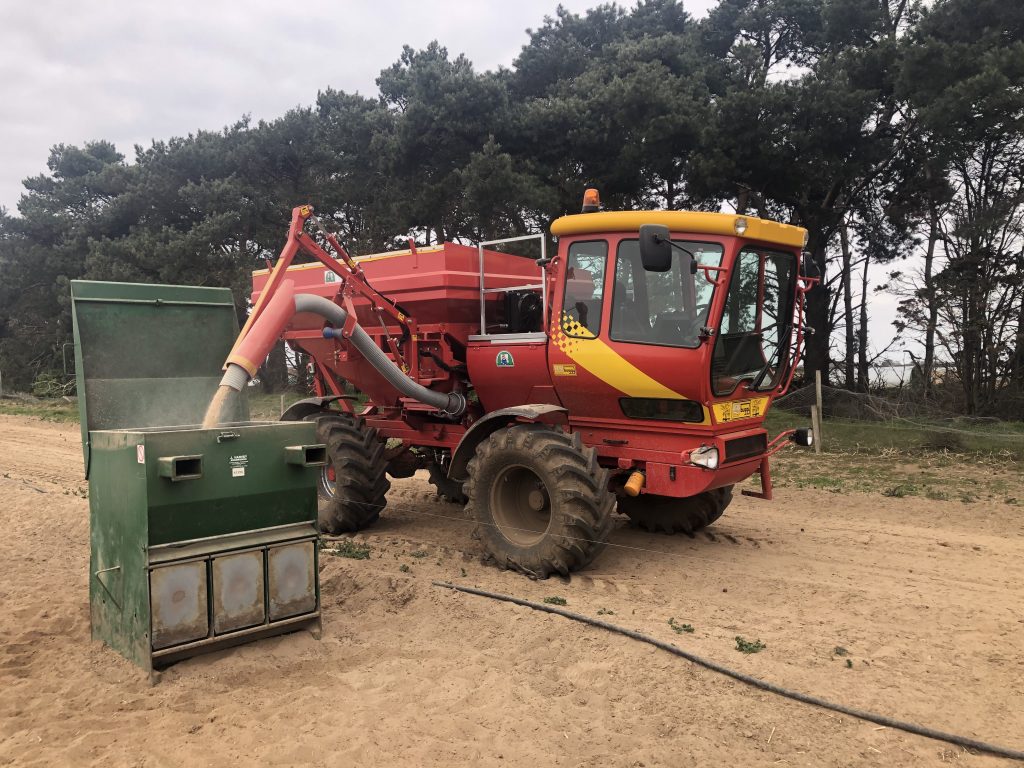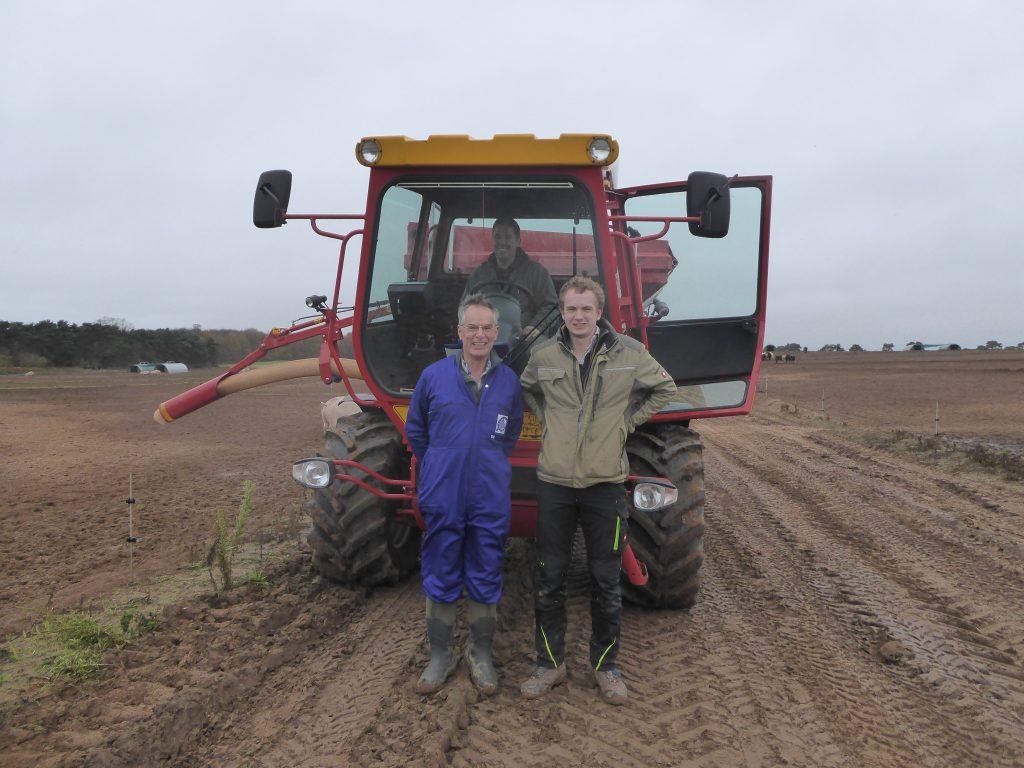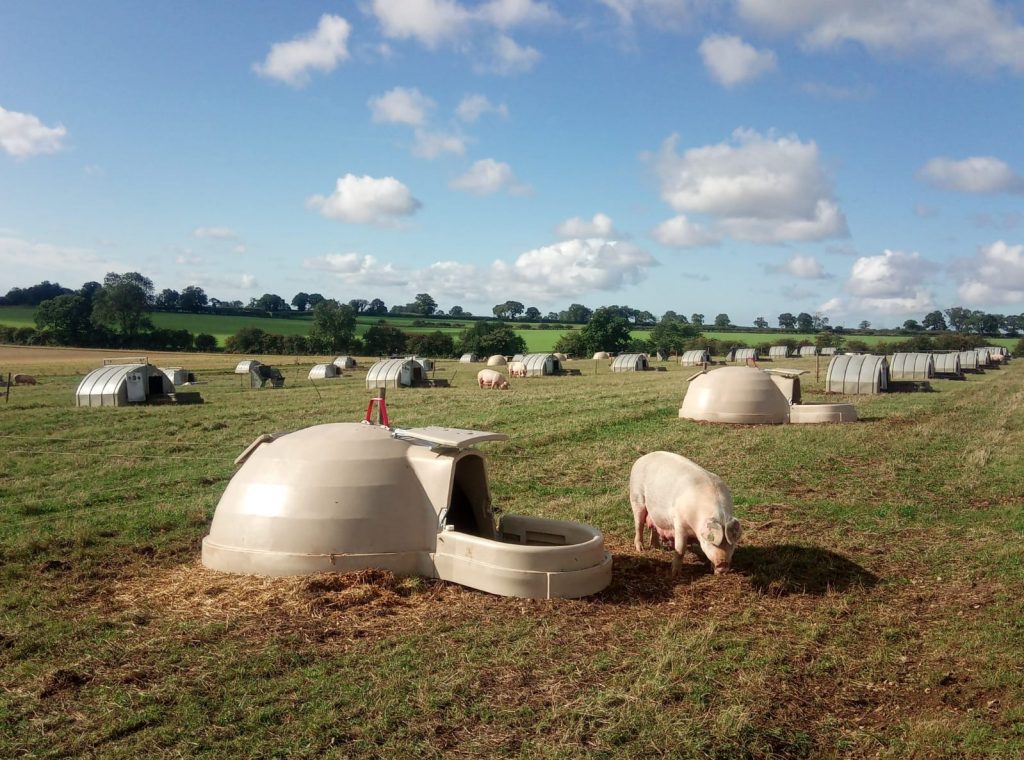Well-fed with hi-tech beds
30th April 2020
Performance-led nutrition and precision-made housing boosts efficiency for one Norfolk herd. Meanwhile, a new venture has found a more ‘ground-friendly’ way to transport feed and move pigs around on units. Jane Jordan reports.
Performance-led nutrition and precision-made housing boosts efficiency for one Norfolk herd. Meanwhile, a new venture has found a more ‘ground-friendly’ way to transport feed and move pigs around on units. Jane Jordan reports.
Prospects for pig production are favourable and UK industry is well-placed to take advantage of shifting market dynamics. At production level, forward-thinking pig businesses are investing in innovative management strategies and new technology to help push performance and raise efficiency.
Contract weaner producer Michael Jones targeted sow nutrition and farrowing accommodation to improve productivity on his 350-sow breeding unit. Moving lactating sows onto a higher energy diet and phasing out traditional wooden framed/steel-roofed farrowing arks, in favour of fully-insulated huts, precision-made plastic huts, is helping him tap more of his herd’s potential. It’s delivering heavier weaning weights, more stabilised sow condition and better reproductive performance – improvements that are benefitting business efficiency.
Michael first tried Contented Products Aardvark and Armadillo huts around two years ago. They performed well, with noticeable improvements to piglet mortality, so when he moved his herd to a larger holding at Binham, North Norfolk in 2018-19, he decided to decommission all traditional arks and replace them with Contented’s 100 per cent insulated huts, including the newly-launched Aardvark XL.
‘Beyond initial expectations’
The Jones’ have been Norfolk county council tenants for almost six years. Their first tenancy, at Mautby near Great Yarmouth, proved successful and the move to Binham offered an opportunity to expand their pig business and pursue a larger more integrated, stewardship-focused livestock/arable enterprise.
However, expansion plans are currently on hold, since the new feeding regime, combined with using insulated farrowing huts, has delivered performance benefits beyond initial expectations.

Tenant farmers Michael and Anneke are expanding their farm business and taking a more integrated, stewardship-focused approach to livestock/arable production. Along with pigs, they hope to develop a small beef herd.
The herd is now rearing more than 11 piglets a litter, with weaning weights between 8.3 and 8.5kg, and production is consistent. Sow efficiency has improved too, as the number of days from weaning to first service has contracted significantly and is now 4–5 days across all parities, with no change to the herd’s 94 per cent conception rate or average numbers born, which is above 14 born, with around 13.9 livebirths (six-month average).
Michael says his Landroc sows have always been prolific and produced good sized litters, but the improvement seen in rebreed interval during the past year has surprised him.
The change was first noted in gilts, but was soon picked up across all parities. Females that farrowed in Aardvarks and Armadillos returned to oestrus earlier post weaning, than those which had reared their young in traditional arks.
“We also noticed how sows housed in Contented’s huts spent more time inside with their young, and how this seemed to benefit mortality rates and weaning weights,” he adds.
The move to Binham was an ideal opportunity to phase out his remaining traditional arks and set up the new site with fully-insulated farrowing accommodation. The investment was substantial, but has paid dividends and added value to the herd’s targeted feeding strategy.
Diet ‘fuelling litter performance’
Sows are fed ForFarmers NutraLac during gestation, a dual-purpose feed that provides the right nutritional support pre-farrowing. Dry sow rations are also increased on day 80 of pregnancy and taking this approach has helped improve birthweights, neo-natal vigour and reduce pre-weaning mortality. MagnaLac, a high-performance lactation diet, is given to all nursing sows They are individually fed and intakes reach an impressive 11–13kg by day 14.
“Our sows have good appetites and the piglets grow quickly. We do offer some creep, but piglet growth is really powered by the sow,” says Michael.
The aim is to wean 100kg of liveweight from each hut; and that’s being achieved. Piglet quality is much better than it was 18 months ago with good numbers born, and more evenly sized new-borns. The sows are also holding their condition, which Michael believes is the reason behind the tighter wean-to-service interval and improved reproductive performance in the subsequent breeding cycle. He also says the combination of more space and better thermal control inside these fully insulated farrowing huts is also influencing productivity and overall herd FCR.
“A larger proportion of what we feed our lactating sows has to be fuelling litter performance because sow condition doesn’t fluctuate much, and we’re getting good piglet growth all year round, even during the summer when feed intakes dip and litter weight can fall off a bit. The environment inside these huts is more stable; if it wasn’t then we’d probably have to feed sows more to keep them fit and maintain litter quality, and that’d be quite a challenge and certainly increase our costs,” he adds.
Aardvark XLs are a recent addition to the farrowing paddocks. These huts are larger than the original model, are taller at 1.15m and offer an extra 0.5m2 floor space. The doorway is wider too and features the new-style ‘up and over’ door.
Contented Products design engineer Jamie Macdonald says: “Many of our customers have asked for a bigger farrowing hut, mainly to accommodate their bigger, older sows, but producers say all ages are responding well to the roomier XL huts, with many herds reporting lower pre-weaning mortality and less straw usage.”
Michael agrees and says he’s getting very good results. He has recently produced an entire batch in Aardvark XLs and records show consistent litter performance and that every productive sow weaned from this group returned to oestrus within four days and was served successfully at first service.
Low pressure developments
Adapted technology could cut compaction and protect ground conditions.

The low ground pressure feeder treads lightly on the land compared with other farm machinery. LGP technology could help pig farmers protect ground and reduce soil damage. Experience in the field shows LGP equipment offers advantages over more traditional farm vehicles.
After struggling through one of the wettest winters on record, many outdoor pig businesses are now seeking more ‘ground friendly’ ways to transport feed and move pigs and equipment around their units.
A collaborative venture between Suffolk-based fabricator J Harvey Engineering and pig breeding and production company Rattlerow Farms, has been exploring how low ground pressure (LGP) technology used in the arable sector could be adapted for use in pig production. The project has developed a self-propelled, LGP feed delivery machine, that can feed pigs in all weather conditions and reduce the risk of excessive ground damage when the land is soft, waterlogged and muddy.
Built on the body of a Kellands/McConnel AgriBuggy – which usually accommodates a self-propelled crop sprayer – the LGP field feeder has a substantial load capacity, but it can successfully negotiate difficult terrain because its overall laden weight is spread across a large surface area. Its gross weight is just 7.5 tonnes, which is 50 per cent lighter than the typical tractor and trailed feeder combination used on many outdoor pig units. The machine also features large flotation tyres, running at 12psi, which help to alleviate compaction and rutting.
Practical advantages
Rattlerow Farms’ joint managing director Adrian Lawson conceived the low-impact idea and believes LGP vehicles have potential. A prototype feeder has been operating on some of its outdoor sites since November 2019 and feedback suggests it has practical advantages over more traditional farm transport.
“The high rainfall we’ve had during winter 2019/20 made conditions extremely difficult on most outdoor units. Even the best sites, on free-draining land, were saturated and it’s been tough trying to maintain ground conditions and prevent excessive rutting and surface run off when feeding pigs and moving equipment. Low ground pressure machinery treads lightly on the land compared with other farm vehicles. Stockmen that have used the Agribuggy feeder say it’s helped save time and reduce the impact everyday tasks were having on saturated land,” he explains.

Adrian Lawson (l) and Fergus Harvey-Kelly (r) with Rattlerow pig unit manager George Chapman driving the newly developed LGP feeder.
Adaptable design spec
The LGP feeder incorporates many of the design features found in J Harvey Engineering’s towed field feed dispenser. The key differences are that the hopper and main body of the feeder are manufactured from mild steel, which is light weight but strong enough to withstand daily use in demanding conditions, and that the hopper and feed delivery system are demountable from the buggy body, so the vehicle could be used to host other implements.
Feeding technology and equipment manager Fergus Harvey-Kelly, says the design spec of this LGP feeder is adaptable and would to suit other vehicles.
“Reducing soil compaction and preserving ground cover are becoming key considerations for outdoor pig businesses, but finding low ground pressure vehicles that are suitable for field feeders isn’t easy. In this case, we wanted a machine that offered a similar power ratio to a tractor. We considered alpine transporters, dumper trucks and other self-propelled sprayers but Rattlerow’s arable manager Martin Sergent suggested the AgriBuggy, and it seemed to suit our needs,” he explains.
Fergus is researching other low ground pressure options, some capable of pulling larger trailers and/or carrying higher volume, other with multi-compartment hoppers. Such equipment would enable different rations to be delivered on one run and minimise the number of journeys a feeding machine needs to make across the farm each day. Another development that’s in the pipeline is a small, feed dispenser designed to fit onto a quad bike or utility vehicle.

